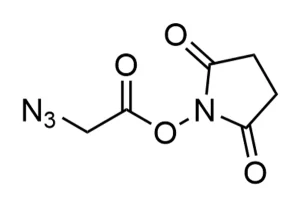MPS (NHS-3-maleimidopropionate), product number QBD-10217, is the N-hydroxysuccinimidyl (NHS) ester of 3-(maleimido)propanoic acid and is used to crosslink sulfhydryls with amines. This product does not contain a dPEG® spacer between the reactive groups. The distance is six atoms (6.0 Å) from the reactive site of the maleimide to the carbonyl carbon of the propanoic acid.
The maleimido group reacts with sulfhydryl groups to form thiol ether bonds. In the range of pH 6.5 – 7.5, the thiol-maleimide reaction is chemoselective. Above pH 7.5, the maleimide group can also react with free amine groups. Consequently, high pH buffers should be avoided when using this product.
NHS esters are widely popular for reactions of carboxylic acids with primary or secondary amines to form stable amide bonds. Although the NHS ester hydrolyzes rather easily in water or aqueous buffer, this product can be dissolved in a water-miscible solvent such as N,N’-dimethylacetamide (DMAC) that has been dried over 3 Å molecular sieves. The solution of MPS is then added to the water or aqueous buffer to start the reaction.
| Unit Size | 250 mg, 1000 mg |
|---|---|
| Molecular Weight | 266.21; single compound |
| Chemical formula | C₁₁H₁₀N₂O₆ |
| CAS | 55750-62-4 |
| Purity | > 98% |
| Spacers | Spacer is 6 atoms and 6.0 Å |
| Shipping | Ambient |
| Typical solubility properties (for additional information contact Customer Support) | DMAC or DMSO. |
| Storage and handling | -20°C; Always let come to room temperature before opening; be careful to limit exposure to moisture and restore under an inert atmosphere; stock solutions can be prepared with dry solvent and kept for several days (freeze when not in use). dPEG® pegylation compounds are generally hygroscopic and should be treated as such. This will be less noticeable with liquids, but the solids will become tacky and difficult to manipulate, if care is not taken to minimize air exposure. |
Applicable patents and legal notices are available at legal notices.




Stay in the Loop. Join Our Online Community
Products
Ordering
About Us
Application
Resources

©Vector Laboratories, Inc. 2025 All Rights Reserved.
To provide the best experiences, we use technologies like cookies to store and/or access device information. Consenting to these technologies will allow us to process data such as browsing behavior or unique IDs on this site. Not consenting or withdrawing consent, may adversely affect certain features and functions. Privacy Statement
How do I Request a Quote?
To request a quote for products: